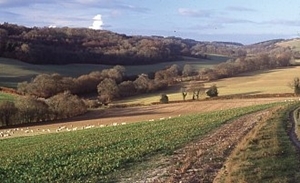 Modern arable systems, with winter cereals and break crops, create a landscape which is uniformly in full growth in spring, but ripening and drying by mid-summer. After an August harvest, the autumn landscape is largely devoid of greenery.
Modern arable systems, with winter cereals and break crops, create a landscape which is uniformly in full growth in spring, but ripening and drying by mid-summer. After an August harvest, the autumn landscape is largely devoid of greenery.
The traditional practice of drilling a brassica, like turnip, into a barley stubble provided some early winter grazing for sheep and cattle on many a mixed farm. These crops also provide a refuge for wildlife. When it is short and newly established it is grazed by hares and deer, as it gets thicker these same animals use it as shelter. By late autumn and early winter such crops are holding pheasants, partridge and flocks of thrushes, redwings and fieldfares. These all enjoy foraging under the protection the brassica provides.
Brassica fodder crops are a good conservation choice for farmers with livestock and arable crops.